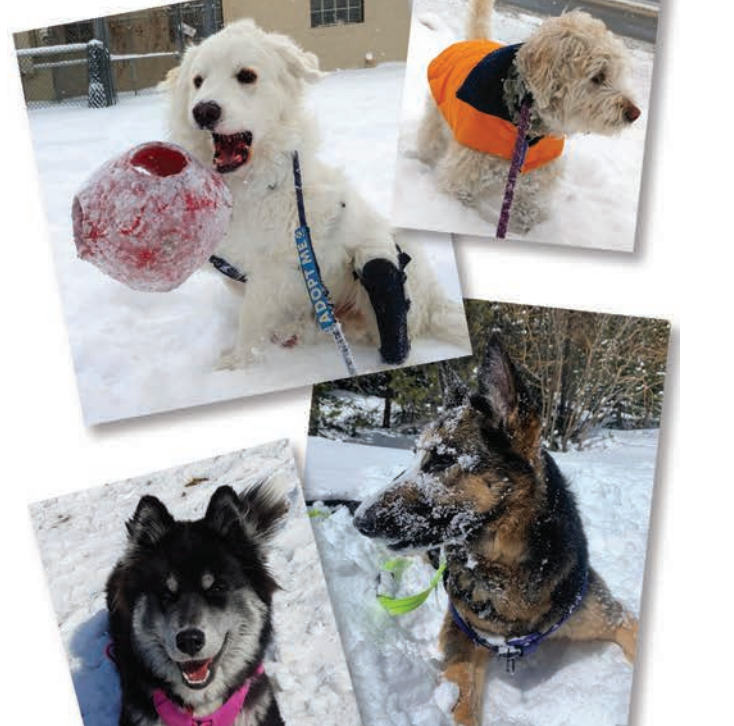Setting You and Your Cat Up For Success Following Surgery
By Janis Martin MARCH 2024 PAWPRINTS
SETTING YOU AND YOUR CAT UP FOR SUCCESS FOLLOWING SURGERY
Frodo, our 10-year old boy cat, had knee surgery (patellar luxation) last fall. He made a full recovery and is back to jumping up on his favorite perch. His recovery required residing in a confined space for six weeks. Frodo is very active and sleeps with me at night. I thought keeping him confined would be torture for both of us - it actually went quite smoothly.
Here are a few lessons, some I learned the hard way, on navigating the recovery process.
Confined Space
I chose the Jespet Soft-Sided 61” Playpen – quickly dubbed The Condo - for his confinement. It was large enough for me to climb inside and hang out with him. He had plenty of room for bedding, a feeding station, and litter pan. Both the bottom and the top zipped closed completely and two zippered doors made feeding and clean-up easy. Lesson learned - I set it up in our living room two weeks prior to his surgery, so he had time to get used to it. He hung out in it often and napping there became part of his daily routine. Allowing him time to accept a new space made coming home to being confined a bit more familiar.
Litter Pans
Litter pan height must be less than two inches for cats recovering from knee surgery. I purchased disposable foil baking trays to use as litter pans. These pans were shallow and easy to throw away after a few uses - convenient for a busy pet parent. An affordable option would be a shallow litter pan or reusable/washable plastic container. Lesson learned - Line the entire confinement area with waterproof pads. Initially I had a towel underneath the pan, which immediately soaked through as groggy Frodo completely missed the pan on the first attempt. A speed run to PetSmart and 20 minutes later, the condo was lined with waterproof pads. They also worked well under the feeding station area, as he knocked over his water bowl frequently during the cone wearing phase.
Rest and Recovery
I thought Frodo would be upset being confined and lonely sleeping alone at night. He was not. I believe he instinctually knew being in his condo was best for him. He slept non-stop most of the first two weeks. In the evenings I would unzip one of the doors and sit with him. After 30 minutes or so, he would start to nudge around me, trying to escape. I learned to limit time with the door open to shorter increments. He received the right balance of love and affection without becoming frustrated by his lack of freedom. Lesson learned – Our pets know they need extra sleep to recover. My initial idea of sleeping in the condo with him, because he would be lonely, was way off base. He needed his sleep and so did I.
Take Cues from Your Cat
The first two weeks were all about caretaking. Limitations of wearing a cone created eating challenges, tipped water bowls, and missed litter box attempts. Halfway through the recovery period, I started sliding his condo over to our bay window during the day. Looking outside provided much needed normalcy. I spent more time in the living room, as he became increasingly interested in activities going on around him. Towards the end of the six-week mark, I replaced the litter pan with his own, bigger box. His sister came in for a few quick visits. At six weeks, he received the all-clear and could move about with supervision. I left the condo up, with the doors open. For the first couple weeks, he slept in it at night. He continued to take daily naps in it, sensing it was a healing space. When he stopped going into it, I put it away. Lesson learned - Recovery went differently, smoother, than I thought it would. Frodo’s understanding of what he needed to heal, and his ability to communicate it to me, allowed me to pivot, taking my cues from him. Not only was his surgery a success, his recovery was, too.
Go Back Frodo, our 10-year old boy cat, had knee surgery (patellar luxation) last fall. He made a full recovery and is back to jumping up on his favorite perch. His recovery required residing in a confined space for six weeks. Frodo is very active and sleeps with me at night. I thought keeping him confined would be torture for both of us - it actually went quite smoothly.
Here are a few lessons, some I learned the hard way, on navigating the recovery process.
Confined Space
I chose the Jespet Soft-Sided 61” Playpen – quickly dubbed The Condo - for his confinement. It was large enough for me to climb inside and hang out with him. He had plenty of room for bedding, a feeding station, and litter pan. Both the bottom and the top zipped closed completely and two zippered doors made feeding and clean-up easy. Lesson learned - I set it up in our living room two weeks prior to his surgery, so he had time to get used to it. He hung out in it often and napping there became part of his daily routine. Allowing him time to accept a new space made coming home to being confined a bit more familiar.
Litter Pans
Litter pan height must be less than two inches for cats recovering from knee surgery. I purchased disposable foil baking trays to use as litter pans. These pans were shallow and easy to throw away after a few uses - convenient for a busy pet parent. An affordable option would be a shallow litter pan or reusable/washable plastic container. Lesson learned - Line the entire confinement area with waterproof pads. Initially I had a towel underneath the pan, which immediately soaked through as groggy Frodo completely missed the pan on the first attempt. A speed run to PetSmart and 20 minutes later, the condo was lined with waterproof pads. They also worked well under the feeding station area, as he knocked over his water bowl frequently during the cone wearing phase.
Rest and Recovery
I thought Frodo would be upset being confined and lonely sleeping alone at night. He was not. I believe he instinctually knew being in his condo was best for him. He slept non-stop most of the first two weeks. In the evenings I would unzip one of the doors and sit with him. After 30 minutes or so, he would start to nudge around me, trying to escape. I learned to limit time with the door open to shorter increments. He received the right balance of love and affection without becoming frustrated by his lack of freedom. Lesson learned – Our pets know they need extra sleep to recover. My initial idea of sleeping in the condo with him, because he would be lonely, was way off base. He needed his sleep and so did I.
Take Cues from Your Cat
The first two weeks were all about caretaking. Limitations of wearing a cone created eating challenges, tipped water bowls, and missed litter box attempts. Halfway through the recovery period, I started sliding his condo over to our bay window during the day. Looking outside provided much needed normalcy. I spent more time in the living room, as he became increasingly interested in activities going on around him. Towards the end of the six-week mark, I replaced the litter pan with his own, bigger box. His sister came in for a few quick visits. At six weeks, he received the all-clear and could move about with supervision. I left the condo up, with the doors open. For the first couple weeks, he slept in it at night. He continued to take daily naps in it, sensing it was a healing space. When he stopped going into it, I put it away. Lesson learned - Recovery went differently, smoother, than I thought it would. Frodo’s understanding of what he needed to heal, and his ability to communicate it to me, allowed me to pivot, taking my cues from him. Not only was his surgery a success, his recovery was, too.

